Regional household income statistics
Data extracted in March 2021.
No planned article update.
Highlights
The four EU regions with the highest primary income per capita in 2018 were all in Germany: Oberbayen, Stuttgart, Darmstadt and Hamburg.
The five EU regions with the lowest primary income per capita in 2018 were Severozapaden in Bulgaria, Mayotte in France, Nord Est in Romania, Severen tsentralen and Yuzhen tsentralen, both in Bulgaria.
The EU regions that recorded the largest increases between 2010 and 2018 in the ratio of their net primary income per capita to the EU average were: Bucureşti - Ilfov in Romania, Sostinės regionas in Lithuania, Yugozapaden in Bulgaria and Nord Vest in Romania.
The EU regions that recorded the largest decreases between 2010 and 2018 in the ratio of their net primary income per capita to the EU average were: Valle d’Aosta/Vallée d’Aoste, Lazio, and Provincia Autonoma di Trento in Italy; Voreio Aigaio, Attiki and Sterea Ellada in Greece.
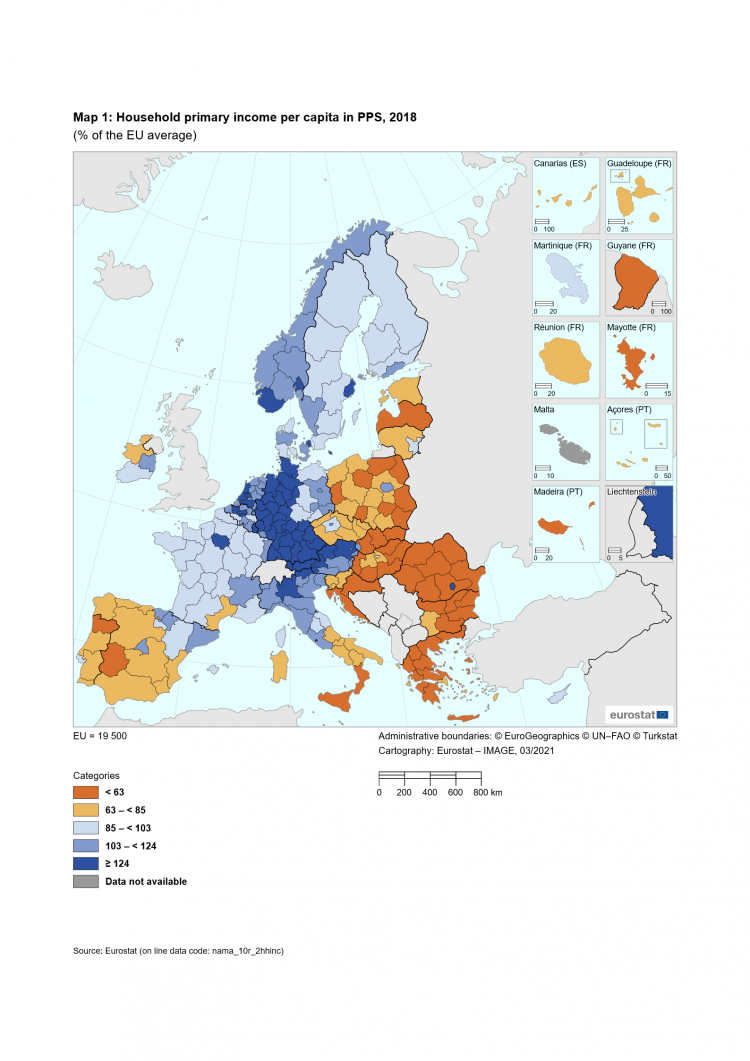
(% of the EU average)
Source: Eurostat (nama_10r_2hhinc)
This article is focused on regional household accounts in the EU for NUTS level 2 regions. The data presented cover the household sector. The selected indicators focus on primary and disposable income as measures of living standards. Taken together these indicators provide more detailed information about societies and living conditions than, for example, looking only at the change in gross domestic product (GDP). There are 240 NUTS level 2 regions that cover the EU Member States: note that Estonia, Cyprus, Latvia, Luxembourg and Malta each have only one region at NUTS level 2. Data from regional household accounts are not available for Malta. The analysis is based on 2018 data, including a comparison with 2010 data.
In this analysis, primary income is presented in relation to GDP and disposable income. It is also analysed in terms of its components (net operating surplus and mixed income, compensation of employees received by households, and net property income).
Full article
Primary income per capita in PPS
Map 1 shows household net primary income per capita across EU regions, expressed as a percentage of the EU average. These data have been compiled based on data in purchasing power standards (PPS), in order to take account of price level differences between regions (see Box 1 for more information).
There were 18 regions where net primary income per capita in PPS in 2018 was more than 140 % of the EU average (19 500). The four regions with the highest primary income per capita in 2018 were all in Germany: Oberbayen (191.3 %), Stuttgart (164.6 %), Darmstadt (161.5 %) and Hamburg (161.0 %). Among the remaining 14 regions, nine were also in Germany and the others were Luxembourg, Prov. Vlaams Brabant (Belgium), Île-de-France (France), Provincia Autonoma di Bolzano/Bozen (Italy) and Vorarlberg (Austria).
By contrast, there were 13 regions with net primary income less than half the EU average. The five regions with the lowest primary income per capita in 2018 were Severozapaden in Bulgaria (29.2 %), Mayotte in France (32.8 %), Nord Est in Romania (34.4 %), Severen tsentralen (35.4 %) and Yuzhen tsentralen (36.4 %), both in Bulgaria. The remaining eight regions were located in Romania (three regions), Bulgaria (two regions) Greece, Hungary and Slovakia (one region each).
Box 1: use of purchasing power parities (PPPs) in household accounts
Purchasing power parities (PPPs) are used to remove price level differences across countries in order to facilitate inter-spatial comparisons. A PPP for GDP is commonly used in national accounts to adjust variables. The use of a single PPP has the benefit of maintaining the additivity of the variables in the system of national accounts. Indicators that have been adjusted using PPPs are expressed in purchasing power standards (PPS), rather than euros. When using a single PPP, GDP expressed in PPS is still equal to the sum of its expenditure components, as is the case for national accounts data in current or previous year’s prices.
However, for specific analysis for parts of the national accounts system, it is preferable to use PPPs that better reflect the coverage of the item being analysed. As households spend most of their income on the final consumption of goods and services, a PPP for that indicator provides a better adjustment for spatial differences in prices.
In many cases, the difference between using the PPP for GDP compared with the PPP for household final consumption will be small, but in some cases the differences are quite substantial. In 2018, the PPP for GDP was substantially lower than the PPP for household final consumption for Luxembourg (124.9 compared with 146.4), Ireland (116.7 compared with 133.3) and Denmark (134.0 compared with 143.1), while the opposite was observed in Bulgaria (51.4 compared with 46.4), Poland (60.5 compared with 55.5) and Lithuania (65.9 compared with 61.7).

(% of the EU average)
Source: Eurostat (nama_10r_2hhinc)
The relationship between primary income and GDP
The ratio of net primary household income to GDP is sometimes noticeably different between regions within a country. It is generally lower in regions that concentrate economic activity, like capital regions, and higher in regions in which many commuters (people who work and live in two different regions) live. While GDP is recorded where it is generated (the place of work), income is recorded in the place of residence of the worker. Furthermore, the kind of economic activity that takes place in a region affects the relationship between net primary income and GDP. In regions specialised in capital (tangible or intangible) intensive activities, the remuneration of workers will generally constitute a lower share of the value added than in regions specialised in more labour intensive activities. As such, it is clear why income per capita is a better indicator of the income of residents for a region than GDP per capita.
The ratio of primary income to GDP, both measured in euros, ranged in 2018 from a low of 26.4 % in Southern (Ireland) to a high of 99.3 % in Lüneburg (Germany).
There were eight regions for which this ratio was less than 50 %. Alongside Southern, these regions were the Région de Bruxelles-Capitale/Brussels Hoofdstedelijk Gewest (34.2 %) in Belgium, Praha (37.6 %) in Czechia, Budapest (39.0 %) in Hungary, Luxembourg (40.0 %), Eastern and Midland (40.7 %) in Ireland, Bratislavský kraj (45.2 %) in Slovakia and Warszawski stołeczny (49.6 %) in Poland.
At the other end of the scale, apart from Lüneburg, there were eight other regions in which the ratio was above 82.0 %: Prov. Luxembourg (97.7 %) in Belgium, Trier (92.8 %) in Germany, Prov. Namur (88.6 %) in Belgium, Burgenland (87.6 %) in Austria, Koblenz (83.9 %) in Germany, Lorraine (83.3 %) in France, Schleswig-Holstein (83.1 %) in Germany and Franche-Comté (82.5 %) in France.
The commuting effect can be clearly seen in Belgium between Namur and the capital city region, in Germany between Lüneburg and Schleswig-Holstein on one hand and Hamburg and Bremen on the other, in France between Picardie and Île de France, in Austria between Niederösterreich and Wien, and even between regions in different Member States as in the case of Prov. Luxembourg, Trier and Lorraine (in Belgium, Germany and France respectively) and Luxembourg. Map 2 offers a general overview for all EU regions.
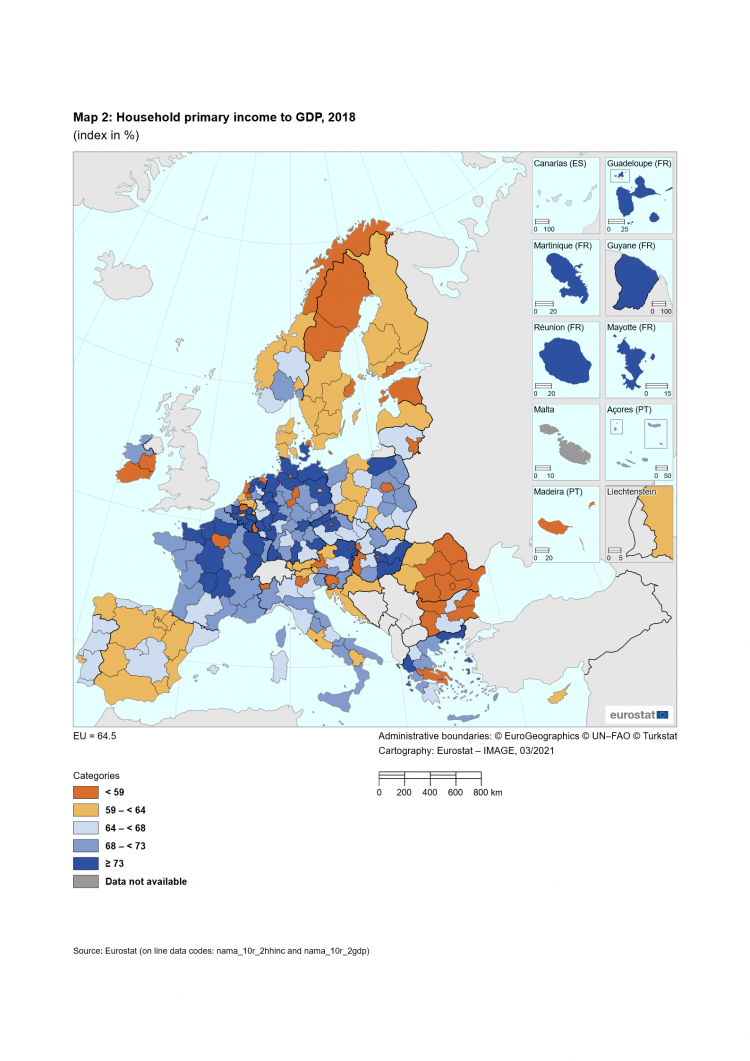
(%)
Source: Eurostat (nama_10r_2hhinc) and (nama_10r_2gdp)
Components of primary income
In this section, the components of household primary income are analysed. The components of primary income are the compensation of employees (national accounts code D.1), net operating surplus and mixed income (B.2n and B.3n) and net property income (national accounts code D.4).
Compensation of employees is defined as the total remuneration, in cash or in kind, including employer’s social contribution, payable by an employer to an employee in return for work done.
Net operating surplus includes the activities of unincorporated enterprises (which are not included in other institutional sectors), housing services to others or own accommodation services (normally called owner-occupied dwelling services) and own-account production of goods by households.
Net mixed income includes the joint remuneration of capital and labour in unincorporated enterprises. For example, for an independent taxi driver who owns a license, it is difficult to estimate from their earnings which part comes from the time spent driving the taxi and which part from owning the license. As the concept is net, the consumption of fixed capital should be deducted from the gross flows.
Property income includes, among other elements, interest received by households from their financial investments (less interest paid on loans), dividends, withdrawals from income of “quasi-corporations”, investment income from insurance or pension entitlements, and rents on land.
The share of each of these components in primary income depends on several factors. In a region in which there are few self-employed people, compensation of employees will represent a high share of primary income, whereas its share will be low if the proportion of self-employed people is high. For employees, remuneration for labour is recorded as compensation of employees while for the self-employed it is included in mixed income. A region in which households reside mainly in dwellings that they own will (generally) have a higher share of net operating surplus and mixed income because it includes owner occupied imputed rents (an amount comparable with the rent paid to live in a similar dwelling); a region in which households mainly rent the dwellings in which they live will (generally) have a lower share of net operating surplus and mixed income. Net property income will depend on the size of the net assets that households own and on the return on those assets. Households in regions with higher income will accumulate net financial assets more easily. Households in countries with less generous public pension systems will accumulate more assets to increase their future pensions compared with households in countries with more generous public pension systems.
In 2018, the share of the compensation of employees was highest (more than 85 % of net primary income) in several Swedish and Danish regions as well as in Estonia. The share of net operating surplus and mixed income in net primary income was highest (above 35 %) in several Greek and Polish regions. Finally, net property income was relatively important (above 15 %) in most German and Italian regions as well as in Lithuania.
The shares of each component to net primary income varied among regions within each Member State, with this diversity notably greater in some Member States than in others. Yugozapaden (84.1 %) in Bulgaria and the Ciudades Autónomas de Ceuta (82.1 %) and Melilla (82.2 %) in Spain recorded notably higher shares for compensation of employees compared with other regions in these Member States (62.3-69.6 % elsewhere in Bulgaria and 65.7-73.2 % elsewhere in Spain). Lower shares for net property income were recorded in the other regions in Hungary (2.6-4.8 %) compared with the relatively high shares in Dél-Alföld (10.1%) and Budapest (8.2%).
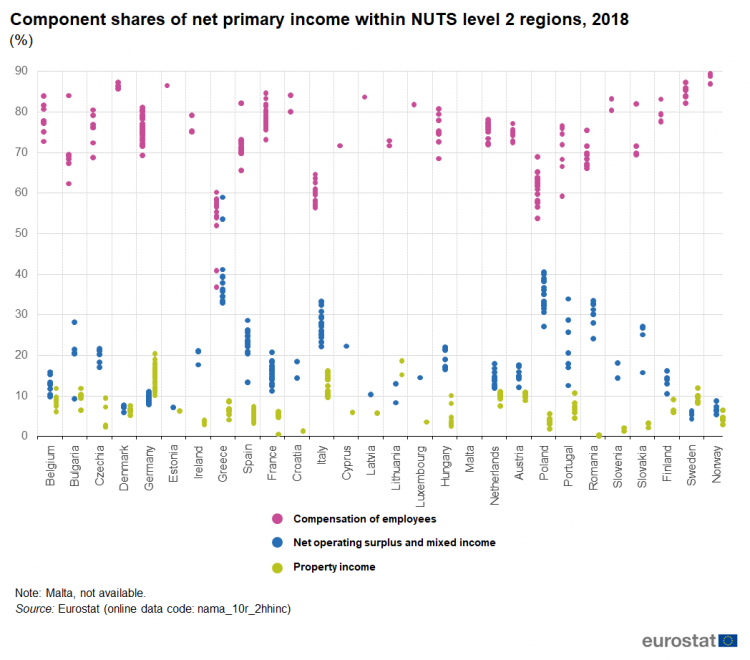
(%)
Source: Eurostat (nama_10r_2hhinc)
Change between 2010 and 2018 in primary household income relative to the EU average
The main observation from the first section of this article was that there are substantial differences in net primary income per capita between EU regions [1]. An analysis of the changes in this indicator over time is informative. Computing the unweighted standard deviation of net primary income per capita in PPS as a percentage of the EU average reveals that this measure of dispersion declined between 2000 and 2008, increased between 2008 and 2014, and declined again between 2014 and 2018.
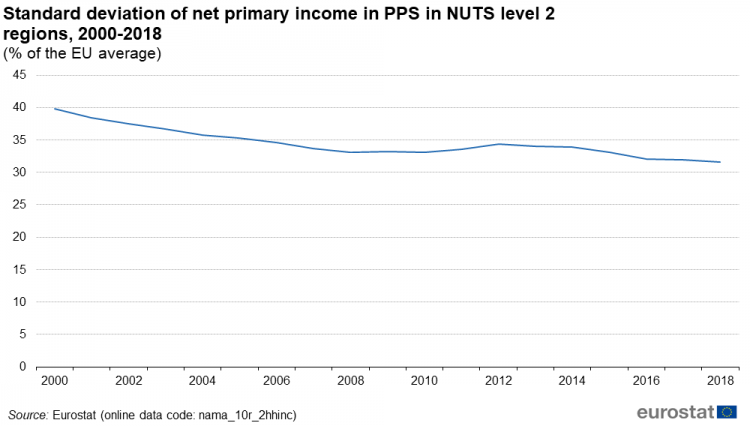
(% of the EU average)
Source: Eurostat (nama_10r_2hhinc)
However, this overall development masks some important changes that have taken place within individual regions. Figure 3 plots net primary income per capita in PPS as a percentage of the EU for NUTS level 2 regions in 2010 and 2018. The x-axis (horizontal) shows the value in 2010 and the y-axis (vertical) the value in 2018. Regions that appear above/left of the diagonal in the figure are regions for which an increase in their value compared with the EU was observed between 2010 and 2018, while those that appear below/right of the diagonal in the figure are those for which a decrease has been observed.

(% of the EU average)
Source: Eurostat (nama_10r_2hhinc)
The plot shows that nearly all of the regions with the lowest values in 2010 (below 60 % of the EU average) are above/left of the diagonal, meaning that their income per capita increased between 2010 and 2018 and therefore moved towards (converged on) the EU average. Regions with a value below 60 % in 2010 were mainly regions in Bulgaria, Croatia, Latvia, Hungary, Poland, Romania and Slovakia.
Regions that were in the 65-85 % range in 2010 generally did not move towards the EU average but moved away from it; in other words, their income relative to the EU average decreased despite already being below the EU average in 2010. The regions in this range (65-85 %) in 2010 that experienced a decline in their income relative to the EU average were mainly located in Greece, Spain, Italy and Portugal.
A clear pattern is not so visible for other initial income ranges but it is for some EU Member States. Most German regions had net primary income per capita in PPS that was above 100 % of the EU average in 2010 and moved further ahead of the EU average by 2018 and are therefore positioned above/left of the diagonal in Figure 3. Most French regions recorded a lower net primary income per capita in PPS relative to the EU average in 2018 than they had done in 2010 (regardless of whether or not their ratio was above or below 100 % in 2010) and are positioned below/right of the diagonal in Figure 3.
The regions that were below the EU average in 2010 and increased by more than 20.0 percentage points by 2018 were Bucureşti - Ilfov (from 90.9 % to 126.7 %) in Romania, Sostinės regionas (67.1 % to 100.0 %) in Lithuania, Yugozapaden (51.2 % to 75.4 %) in Bulgaria and Nord Vest (31.7 % to 52.3 %) in Romania. There were some regions that recorded decreases of more than 20.0 percentage points: Valle d’Aosta/Vallée d’Aoste (132.9 % to 107.7 %), Lazio (129.9 % to 105.6 %) and Provincia Autonoma di Trento (136.6 % to 112.8 %) in Italy; and Voreio Aigaio (78.0 % to 53.3 %), Attiki (99.4 % to 75.9 %) and Sterea Ellada (72.6 % to 51.3 %) in Greece.
Regional income differences within EU Member States
In the previous sections the regional differences of household primary income across EU regions have been described, along with the components and changes over time of this income. In this section the focus is on regional differences within EU Member States. Rather than net primary income, a more appropriate measure of regional differences in household income within Member States is net disposable income — see Box 2. To calculate net disposable income, income taxes (national accounts code D.5) and net social contributions (national accounts code D.61) are deducted from primary income while net social benefits (other than social transfers in kind) (national accounts code D.62) and net current transfers (national accounts code D.7) are added.
The deduction of income taxes tends to reduce differences between regions, as they are generally progressive. As such, households in regions with higher incomes are normally taxed at higher rates. The same can be expected for net social contributions, as regions with higher primary income generally tend to have higher employment rates. The opposite can be expected from net social benefits (other than social transfers in kind) and net current transfers. Regions with higher unemployment, more older people or a generally more vulnerable population are likely to receive proportionally more unemployment benefits, pensions and other kinds of monetary benefits. Bearing these points in mind, it can be inferred that regional inequalities for disposable income depend on the inequalities in primary income as well as inequalities in other factors (such as income tax and social benefits and transfer systems, differences in age structure and unemployment rates between regions).
Box 2: comparing regional income in different Member States
Even though Eurostat collects and publishes regional data on net disposable income, it is not recommended to use these data to compare the income in regions of different EU Member States. The reason for this is that net disposable income removes from household income the payments made to government but does not include some goods and services provided by government for free or at prices that are not economically significant (in other words, social transfers in kind (national accounts code D.63)). Most national statistical offices do not compile regional data for social transfers in kind.
If, for example, net primary income (national accounts code B.5N), net disposable income (B.6N) and net adjusted disposable income (B.7N = B.6N + D.63) are compared for the Netherlands and Belgium in 2018, it can be seen that net primary income per capita was EUR 1 300 higher in the Netherlands (27 500) than in Belgium (26 200), while net disposable income was EUR 1 000 lower in the Netherlands (20 200) than in Belgium (21 200) and net adjusted disposable income was EUR 300 higher in the Netherlands (27 900) than in Belgium (27 600).
To compare the extent of regional differences within each EU Member State, the standard deviation of net primary income and net disposable income per capita as percentage of the national average has been compiled, using population weights for each region in each country. This has been done for all Member States with more than two NUTS level 2 regions. The highest levels of regional dispersion (in other words the highest standard deviations) for net primary income in 2018 were recorded for Romania (50.7), Bulgaria (38.7) and Slovakia (30.5), while the lowest were recorded for Denmark (10.5), the Netherlands (8.4) and Austria (5.2). For disposable income, the highest and lowest levels of regional dispersion were recorded for the same Member States, but for Denmark (4.3) the regional dispersion was lower than for the Netherlands (4.6). In all Member States, the standard deviation was lower for disposable income than for primary income. In Czechia and Ireland, the difference between the levels of regional dispersion for these two indicators was quite small while for France and Poland it was relatively substantial.
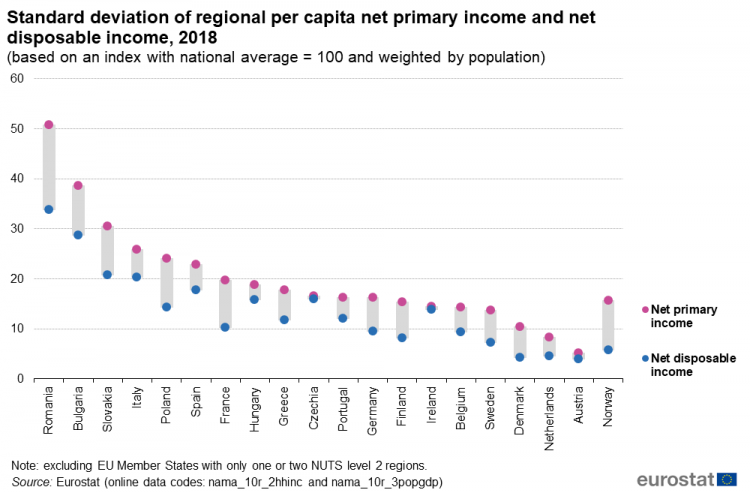
(based on an index with national average = 100 and weighted by population)
Source: Eurostat (nama_10r_2hhinc) and (nama_10r_3popgdp)
How the change from net primary income to net disposable income affects a region’s relative position compared with the national average can be seen by calculating the ratio between the two.
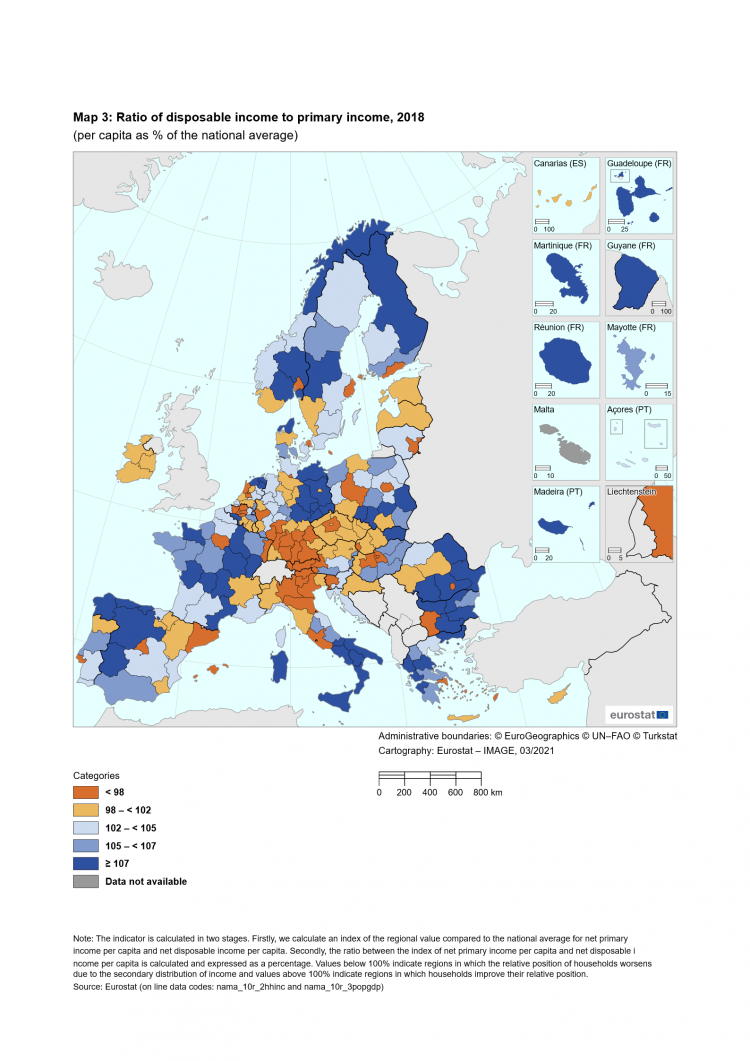
(per capita as % of the national average)
Source: Eurostat (nama_10r_2hhinc) and (nama_10r_3popgdp)
For example, in 2018 net primary income per capita of Warszawski stołeczny in Poland was 175 % of the average for Poland, while net disposable income per capita was 137 %. The ratio of the second of these ratios to the first of them was 78 %. Other regions for which the ratio was below 90 % were Bucureşti - Ilfov (81 %) in Romania, Île-de-France (85 %) in France, Bratislavský kraj (86 %) in Slovakia and Oberbayern (89 %) in Germany.
By contrast, Chemnitz in Germany had a net primary income per capita equal to 72 % of the German average, while net disposable income was 90 % of the national average, resulting in a ratio of the latter to the former that was equal to 125 %. Other regions in which the ratio was above 115 % were Sachsen-Anhalt (120 %) in Germany, Nord-Est (119 %) in Romania, Severozapaden (118 %) in Bulgaria, Mecklenburg-Vorpommern (118 %) in Germany, La Réunion (117 %) in France, Dresden (117 %) in Germany, Principado de Asturias (116 %) in Spain, Calabria (116 %) in Italy, Limousin (116 %) in France and Thüringen (116 %) in Germany.
It can be seen from Figure 4 and Map 3 above that, even though the use of net disposable income rather than net primary income leads to a narrower range of regional values for some EU Member States (for example Bulgaria, Romania and Slovakia), the high regional dispersion observed for net primary income still translates into a relatively pronounced regional dispersion (compared with other Member States) for net disposable income.
Source data for tables and graphs
Data sources
Regional accounts data are compiled annually based on the ESA 2010 requirements and in accordance with the transmission programme. For this article, the latest household data available for NUTS level 2 regions refer to the year 2018.
Context
In her political guidelines for the European Commission for 2019-2024, President van der Leyen highlighted a desire to strive for a European economy that works for people, based on social fairness and prosperity. To do so she called, among other actions, for a deepening of economic and monetary union, greater support for small and medium-sized enterprises (SMEs), the full implementation of the European pillar of social rights, and fairer taxation.
Notes
- ↑ For an analysis of GDP per capita differences please refer to: https://ec.europa.eu/regional_policy/sources/docgener/work/022020_convergence_redux.pdf.
Direct access to
- Building the system of national accounts — online publication
- European system of national and regional accounts — ESA 2010 (background article)
- Economy at regional level
- GDP per capita, consumption per capita and price level indices
- National accounts and GDP
- Regional accounts — an analysis of the economy for NUTS level 3 regions
- Regional economic accounts - ESA 2010 (t_reg_eco)
- Regional economic accounts - ESA2010 (t_nama_10reg)
- Regional economic accounts (reg_eco10)
- Branch and household accounts (reg_eco10brch)
- Regional economic accounts (nama_10reg)
- Branch and household accounts (nama_10r_brch)
- Maps can be explored interactively using Eurostat’s statistical atlas (see user manual)
- Regional statistics illustrated
- Regions in Europe — statistics visualised is a digital publication that offers a range of interactive visualisations that allow you to get a deeper understanding of the situation across European regions
Manuals and further methodological information
- ESA 2010 — manuals and guidelines
- Manual on regional accounts methods — 2013 edition
- Methodological manual on territorial typologies — Eurostat — 2018 edition
Metadata
- Regional economic accounts (ESMS metadata file — reg_eco10_esms)
- European Commission — Economic and financial affairs
- European Commission — EU regional and urban development
- European Commission — European structural and investment funds
- European Commission — InvestEU programme (2021-2027)
- European Commission — New cohesion policy
- European Commission — 2030 agenda for sustainable development